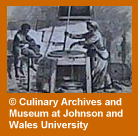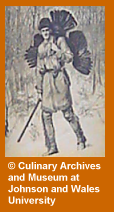Beef is the core, the essence of American food history. Oxen pulled covered wagons westward; cows produced milk for pioneer families; cowboys and cowgirls punched herds along the Chisholm Trail. The story of beef IS American history: a story of challenge, survival, invention, and hard work. From steaks to hamburgers; from classic beef stew to up-scale flavored jerky. Americans have chewed on beef for nearly 400 years and today, average annual consumption by Americans is estimated at 112 pounds.
THE HAMBURGER:
HOW IT CAME ABOUT
The word hamburger probably existed by the end of the Middle Ages. In 1802 the Oxford English Dictionary defined "Hamburg steak" as salt beef. Referring to ground beef as "hamburger" dates to the invention of the mechanical meat grinder during the 1860s. "Filet de boeuf a la Hambourgeoise," was sold in Boston in 1874, while Hamburger Beef Steak appeared on the Lookout House Restaurant menu in Cincinnati, Ohio, in the mid-1870s. During the last years of the 19th century ground round or hamburger became associated with a hot sandwich, and early 20th century illustrations depict hamburger served on sliced white bread or toast. "Hamburger Steak, Plain" and "Hamburger Steak, with Onions," was served at the Tyrolean Alps Restaurant at the 1904 Saint Louis World's Fair.
The modern hamburger (on a bun) appears during World War I. The White Castle restaurant chain was established in 1916 at Wichita, Kansas and by the early 1920s sold hamburgers. Some scholars say the first hamburger served on a bun appeared in 1917 at Drexel's Pure Food Restaurant, Chicago. By 1920 hamburgers on buns were sold in San Francisco and Cincinnati, and by the mid-1920s, hamburgers were recognizable to most Americans. Hamburger popularity continued to grow, and became associated with mobility and the concept of "fast food." The hamburger as an icon of American popular culture spread globally during the 1980s and 1990s with franchise restaurants opening around the world. American-style "burgers" can be purchased today from Moscow to Quito and from Tokyo to Cairo. [6: 1]
Did You Know?
|
BETWEEN TWO CULTURES
Wohaw stands at the junction between two cultures. The old culture to the left is represented by buffalo and teepee symbols, the new European culture to the right is represented by cattle, cultivated fields, and frame houses. In a traditional gesture of respect, Wohaw offers the sacred pipe equally to the revered buffalo, the prairie cattle of the Kiowa, and to the European?s spotted cow. Wohaw appears to accept the inevitable: his face is turned to the new life.
Description of a drawing by Wohaw
(Kiowa prisoner held at
Fort Marion, Florida)
January, 1877 [6:2]

AN AFRICAN-AMERICAN RECIPE:
I learned the cooking game from an African cook brought to America in the days of slavery...
One half of coconut is the base for a filling composed of diced chicken, pork, and beef. Then grated coconut is sprinkled over the top, and it is ready for the oven.
Charles Gant [6:3]

FRIENDS AND FOES: FOOD AND FRIENDSHIP
Geronomo used to come to our place quite often. Once he brought me a big wild turkey and another time he gave me a nice basket. In 1887 we moved to Lincoln County, New Mexico, where we lived during the Lincoln County War. I gave Billy the Kid several meals when he would come to our place . . . as I felt so sorry for him when he said he was hungry.
Annie E. Lesnett [6:5]

THE ALL AMERICAN (BUT ACTUALLY GERMAN) HOT DOG:
Sausages produced in Frankfurt, Germany, were introduced to American tastes in St. Louis, Missouri, during the 1880s. Harry Stevens popularized frankfurter sales at the Polo Grounds baseball park in New York City. The term "hot dog" was coined by cartoonist T. A. Dorgan in 1906. [6:6]
|
 |
|
WOMEN ALSO DROVE CATTLE
I could stay in my saddle from morning until night. At sundown the cook struck camp and prepared supper, which consisted of chili beans, flavored with garlic, fried calf meat, or broiled calf ribs, biscuit bread, baked in a big iron skillet (now called a Dutch Oven), black coffee, stewed dried apples, and molasses. When a meal was ready, the cook would holler -- "Come and get it, or I am going to throw it out."
Mrs. Jack Miles [6: 4]
|
|




